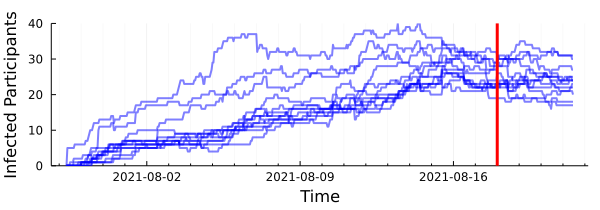
New Zealand’s recent COVID-19 outbreak has allowed a collaborative research project to monitor the effectiveness of lockdown measures in real time, thanks to a virtual ‘virus’.
Earlier this year, the Safe Blues app was – via University of Auckland collaborators and The University of Queensland’s AI 4 Pandemics group leader Associate Professor Yoni Nazarathy – launched, ‘infecting’ the mobile phones of volunteers at the University of Auckland with virtual tokens.
“The tokens acted as digital ‘pathogens’, spreading the way a contagious disease would,” Dr Nazarathy said.
“Using the data gathered from the tokens’ distribution, we’ve discovered that the recent lockdown measures introduced in Auckland reduced the spread of the virus in as little as four days.
“The technology allowed us to harmlessly mimic the virus and watch changes in contagion in the community as they happen.”
The unfortunate NZ outbreak has meant the Safe Blues monitoring trial in Auckland has come to life, allowing researchers to potentially provide information to authorities instantly.
“It’s all thanks to our volunteers on campus at the University of Auckland, who host otherwise-inert virtual tokens on their phones, which can spread via Bluetooth between participants’ phones.
“The tokens jump from phone to phone, mimicking the spread of COVID-19, but rather than being hidden to us – as COVID-19 exposure is – we can see what’s occurring in the community instantly.”
A random subset of the volunteers was infected with the latest trial of the virtual virus three weeks ago and, on the day of the New Zealand lockdown, an average of about 25 participants were ‘infected’.

By chance, this number was similar to the estimated number of COVID-19 delta strain vectors on that very day.
“This parallel, digital ‘virus’ is offering us great live data,” Dr Nazarathy said.
“But, despite Safe Blues’ live measurements already showing that the number of exposed participants is decreasing, the number of infected participants appears to be remaining constant.
“It’s a trend that we largely are seeing in many communities – it’s clear that the delta strain is a significant challenge, making the need for live data on lockdown and other virus suppression measures more vital than ever.
“In the coming days we’ll continue to track the state of the Safe Blues virtual safe epidemics in parallel to actual case numbers reported from New Zealand.”
Live updates can be accessed via the AI 4 Pandemics project page.
A detailed overview of the Safe Blues technology and experimental trial was published in Cell Press (DOI: 10.1016/j.patter.2021.100220).
Safe Blues is a joint project between researchers from UQ, The University of Auckland, The University of Melbourne, Cornell University, Columbia University, Massachusetts Institute of Technology, Macquarie University and Delft University of Technology.
Media: Associate Professor Yoni Nazarathy, y.nazarathy@uq.edu.au, +61 499 028 705; Dominic Jarvis, dominic.jarvis@uq.edu.au, +61 413 334 924.



